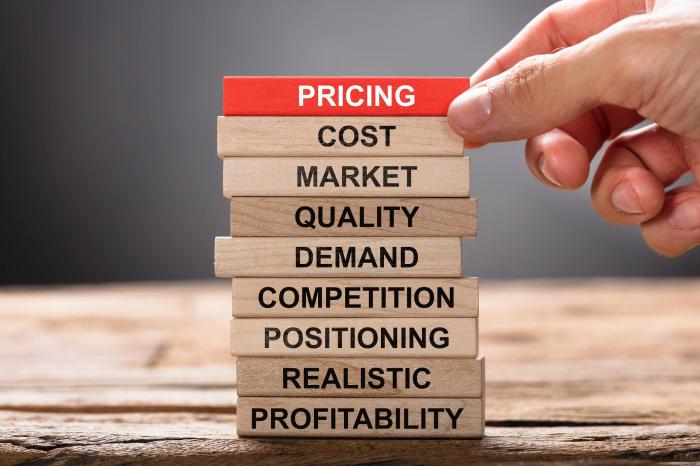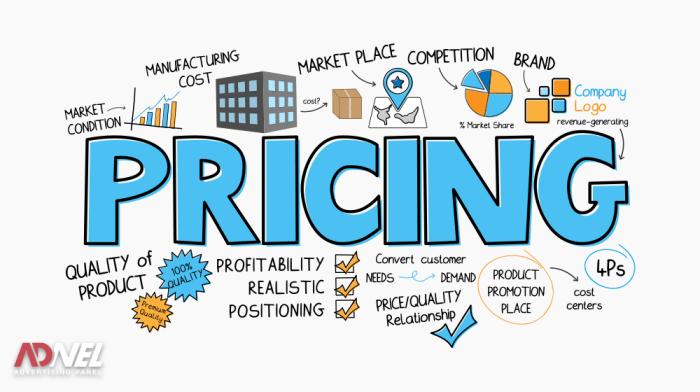Product Pricing Strategies: Get ready to dive into the world of maximizing profits through smart pricing tactics. From cost-based to value-based strategies, this journey will uncover the secrets behind successful pricing strategies in the business realm.
Are you ready to unlock the power of pricing to drive your business forward? Let’s explore the ins and outs of Product Pricing Strategies together.
Overview of Product Pricing Strategies

In the competitive world of business, product pricing strategies play a crucial role in determining the success and profitability of a company. The way a product is priced can greatly influence consumer behavior, market competition, and ultimately the overall performance of a business.
Types of Product Pricing Strategies
- Penetration Pricing: This strategy involves setting a low initial price to attract customers and gain market share quickly.
- Price Skimming: Price skimming involves setting a high price initially to target early adopters and recoup costs before gradually lowering the price.
- Premium Pricing: Premium pricing is when a product is priced higher to convey a sense of exclusivity and quality to the customers.
- Economy Pricing: Economy pricing focuses on offering products at a low price to appeal to price-sensitive customers.
- Psychological Pricing: This strategy involves setting prices that appeal to customers’ emotions and perceptions, such as setting prices at $9.99 instead of $10.
Impact of Pricing Strategies on Consumer Behavior and Market Competition
Product pricing strategies have a significant impact on consumer behavior, as they can influence how customers perceive the value of a product and whether they make a purchase. Additionally, pricing strategies can affect market competition by influencing how competitors respond and positioning a company within the market.
Cost-Based Pricing

Cost-based pricing is a pricing strategy where a company determines the price of a product or service by taking into account the total cost of production and adding a markup to cover overhead costs and generate profit.
Calculation of Cost-Based Pricing
Cost-based pricing is calculated by adding up all the expenses incurred in producing a product or service, including materials, labor, and overhead costs. Once the total cost is determined, a markup percentage is added to cover indirect costs and profit.
Total Cost + Markup Percentage = Selling Price
Examples of Cost-Based Pricing Strategies
- A bakery determines the cost of ingredients, labor, and overhead for baking a cake, then adds a 50% markup to set the selling price.
- An auto repair shop calculates the cost of parts and labor for fixing a car, then adds a 30% markup to determine the service price.
Advantages of Cost-Based Pricing
- Easy to calculate: Cost-based pricing is straightforward to calculate as it involves adding up all production costs.
- Assures profitability: By including a markup for profit, companies can ensure they are making money on each sale.
- Competitive pricing: Cost-based pricing allows companies to set prices based on their costs, which can help them stay competitive in the market.
Disadvantages of Cost-Based Pricing
- Ignoring market demand: Cost-based pricing does not take into consideration customer demand or willingness to pay, which can result in pricing products too high or too low.
- Not flexible: If production costs change, the pricing may become outdated and not reflective of current market conditions.
- Missing out on value: Cost-based pricing focuses solely on costs and may overlook the value that customers perceive in a product, leading to missed opportunities for higher pricing.
Value-Based Pricing
Value-based pricing is a strategy where prices are set based on the perceived value of a product or service to the customer, rather than solely on the cost of production. This approach takes into account the benefits that the product offers, the demand for it in the market, and the willingness of customers to pay a certain price.
Benefits of Value-Based Pricing
- Maximizes profits by capturing the value that customers are willing to pay for
- Allows for flexibility in pricing based on customer segments and their perceived value
- Helps in building a strong brand image and customer loyalty
Examples of Successful Implementation
- Apple: Apple prices its products like iPhones and MacBooks based on the premium value they offer to customers, rather than just the production cost.
- Ritz-Carlton: This luxury hotel chain uses value-based pricing to charge premium rates for its high-end services and amenities.
Comparison with Other Pricing Strategies
Value-based pricing differs from cost-based pricing where prices are set based on the production cost plus a markup. It also contrasts with competition-based pricing where prices are influenced by competitors’ pricing strategies. Value-based pricing focuses on the value perceived by customers, allowing for higher prices if the product is perceived as offering unique benefits or solutions.
Competition-Based Pricing
Competition-based pricing is a strategy where companies set their prices based on what their competitors are charging for similar products or services. This pricing approach is significant in the market as it helps businesses stay competitive and attract customers by offering prices that are in line with or better than their rivals.
Adjusting Pricing Based on Competitors
Companies often monitor their competitors’ pricing strategies closely and make adjustments to their own pricing accordingly. If a competitor lowers their prices, a company might choose to match or undercut those prices to retain customers. On the other hand, if a competitor raises their prices, a company might see an opportunity to increase their own prices without losing customers.
- Companies may use pricing intelligence tools to track competitors’ prices in real-time and make quick pricing decisions.
- Dynamic pricing algorithms can help companies automatically adjust prices based on competitors’ pricing changes.
- Some companies engage in price wars with competitors, continuously lowering prices to gain market share even at the expense of profitability.
Challenges of Competition-Based Pricing
- It can lead to a race to the bottom, where companies constantly lower prices to match competitors, decreasing profitability.
- Companies may lose brand value and customer loyalty if they are perceived as always chasing the lowest price in the market.
- Competitors may engage in price-fixing or predatory pricing practices, making it difficult for companies to compete fairly.
Dynamic Pricing
Dynamic pricing is a strategy where businesses adjust the prices of their products or services in real-time based on various factors such as demand, competition, and customer behavior. This approach allows companies to maximize revenue and profit by setting prices that are most suitable for specific market conditions.
Technology behind Dynamic Pricing Algorithms, Product Pricing Strategies
Dynamic pricing algorithms rely on sophisticated software and data analysis to continuously monitor market dynamics and make pricing decisions. These algorithms take into account factors like competitor pricing, customer segmentation, historical sales data, and even external events like weather patterns or holidays to determine the optimal price for a product or service.
Advantages of Implementing Dynamic Pricing Strategies
- Maximizing revenue by adjusting prices based on demand fluctuations.
- Optimizing profitability by setting prices that align with market conditions.
- Enhancing competitiveness by quickly responding to changes in the market environment.
- Improving customer satisfaction by offering personalized pricing based on individual preferences.
Potential Risks of Implementing Dynamic Pricing Strategies
- Risk of alienating customers if they perceive price changes as unfair or discriminatory.
- Potential backlash from consumers who may feel manipulated by fluctuating prices.
- Regulatory concerns regarding price discrimination and antitrust issues.
- Complexity in managing pricing algorithms and ensuring transparency in pricing decisions.












